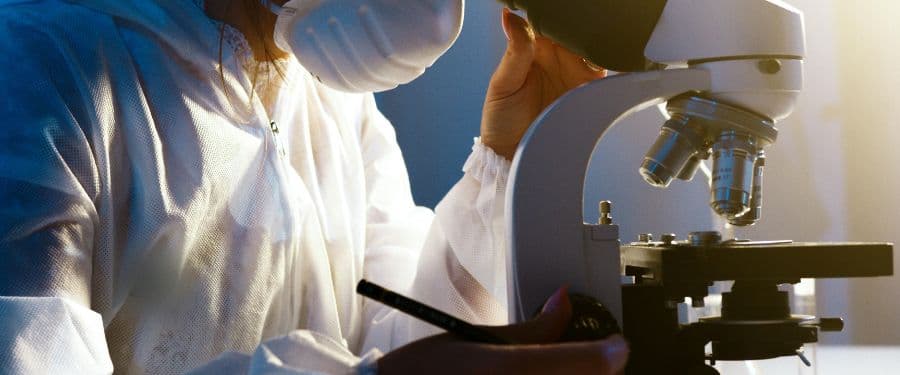- Space Availability
- Neighborhood Planning
- Portfolio Evaluation
- Dynamic Operations
- Intelligent Space Design
- Product
5 Ways Life Sciences Companies Can Optimize Office and Lab Spaces with Occupancy Intelligence

VergeSense is the industry leader in providing enterprises with a true understanding of their occupancy and how their offices are actually being used.
Over the last several years, life sciences companies have increasingly shifted to more flexible and dynamic workplace models, adopting strategies like unassigned seating and activity-based work. These new work models have revolutionized how employees interact with their spaces, making it critical for workplace leaders to adapt. However, the complexities of managing office spaces, labs, and manufacturing facilities mean that life sciences companies face unique challenges.
Optimizing these spaces for collaboration, productivity, and efficiency requires data-driven insights that offer a clearer understanding of how spaces are being utilized. Occupancy intelligence provides this clarity, helping leaders make informed decisions about space usage, design, and optimization.
Here are five ways occupancy intelligence can help life sciences companies unlock the full potential of their spaces:
1. Make Data-Driven Design Changes with Usage Maps
One of the top priorities for workplace leaders is understanding which spaces are the most and least popular. Without data, these decisions are often subjective and based on assumptions.
Usage Maps give life sciences leaders the ability to visualize where employees spend the most time and which areas are underutilized. These insights can guide decisions to repurpose unpopular spaces and scale up popular ones to meet demand. This data ensures that office designs are employee-centric, fostering higher engagement and productivity both inside and outside the lab.
2. Identify Inefficiencies with Passive Time Analytics
Sometimes, popular spaces may appear unused during certain times or days. Without the right data, it’s difficult to understand why these fluctuations happen. Passive Time Analytics offers a unique solution, tracking objects like laptops and bags that indicate someone has claimed the space, even if they’re not physically present.
Only VergeSense offers passive occupancy detection. This innovation identifies common objects that indicate human presence, even when no one is physically there. This type of occupancy constitutes up to 50% of all usage. This knowledge empowers leaders to understand inefficiencies in how their employees are using the office so they can make necessary changes to the spaces themselves and encourage behavior changes when necessary.
For example, one global biotech company discovered that spaces occupied by objects accounted for up to 50% of total occupancy, allowing them to accommodate 30% more employees and avoid a costly $13M expansion.
3. Use AI-Powered Insights to Enhance Facility Management
AI-powered solutions like Workplace Assistant offer life sciences leaders the ability to harness data-driven insights to improve facility management, compliance, and operational outcomes. Workplace Assistant can analyze trends, predict needs, and provide recommendations to optimize workspace efficiency.
By leveraging AI-powered tools, life sciences companies can streamline decision-making processes, improve space utilization, and feel confident in their strategies. These tools act as a personalized advisor, offering actionable insights that save time and resources.
4. Eliminate Ghost Meetings with Space Booking Automation
In many office environments, meeting rooms are frequently booked but go unused, leading to “ghost meetings” that take up valuable space. For life sciences companies, this creates friction and inefficiency as employees search for available rooms to collaborate.
With Space Booking Automation companies can optimize their space availability and reduce wasted time for employees. By integrating with leading booking systems, space can be automatically booked or released based on the presence or absence of people or objects in a given space eliminating ghosted meetings for good.
5. Enhance Employee Experience with Real-time Availability via Kiosks
Life sciences campuses are often large and complex, making it challenging for employees to find available workspaces quickly. Real-time Availability via Kiosks provide employees with an overview of open spaces across an entire campus or building.
With real-time data, employees can reserve spaces without the frustration of wandering around looking for an open desk or meeting room. This system ensures a frictionless employee experience and encourages better space utilization across multiple floors or buildings
Optimize Your Workplace with VergeSense
In an industry where collaboration and innovation are key to success, life sciences companies need to optimize their office spaces and campuses to foster productivity and efficiency. The Occupancy Intelligence Platform provides life sciences workplace leaders with the data-driven insights they need to tackle the unique challenges they face. By understanding space utilization trends and leveraging technology like AI-powered tools and passive occupancy detection, life sciences companies can create environments that support both their employees and their bottom line.
With VergeSense, companies can continuously improve their spaces, enhance employee experiences, and unlock the full potential of their workplace. Let’s build smarter, more efficient workspaces together.
Want to learn more about how VergeSense can support life sciences companies? Download our comprehensive ebook, “Transforming Life Sciences Workplaces with Occupancy Intelligence report” to explore five critical use cases and discover how leading financial institutions are leveraging data to drive success.